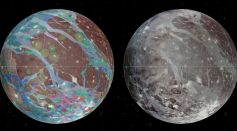Tags: Solar System
NASA Scientists Testing Asteroid Deflection Methods To Prevent Space Rocks From Hitting Earth
Solar System Geological Features That You Must Know: Which One's the Most Impressive?
Why Was Pluto Demoted 15 Years Ago? Controversial Definition of Planets Disagreed by Some Astronomers
Over 100 Trillion Objects at the Oort Cloud Icy Edge of the Solar System Are From Interstellar Space Like Comet 2I/Borisov

Will This Fastest Orbiting 0.6-Mile Wide Asteroid Found in Solar System Reach Earth?
Solar System May Be Full of Interstellar Objects Than Previously Thought
Jupiter in Relatively Large, Bright Sight When It Positions Opposite the Sun; Watch As It Happens on August 20
Solar System Estimated to Be Much Younger at 4.55 Billion Years Based on Magnetism Analysis

New Rocky Exoplanet Half the Mass of Venus Discovered in Another System Orbiting Star L 98-59

Nearby Star Resembles Young Version of Sun; Could Shed Light on How Life Began on Earth
Exoplanet 35 Light-Years Away from Earth Has 320 Degrees Fahrenheit Temperature; Hot Enough for Baking
Two Mysterious Red Rocks Discovered in Asteroid Belt Between Mars and Jupiter That May Hold Clues on Solar System's History
Rare 4.6-Billion-Year-Old Meteorite Discovered in England Found Lying in Imprint of a Horseshoe

Why Is Venus So Bright? Here's How Its Proximity to Earth, Highly Reflected Clouds Affects It

Solar System Is Expecting a Visitor From the Oort Cloud Soon; Could It Be Among the Largest Comets Yet?
Gaseous Planets Orbiting Bright Star Discovered: Citizen Scientists Finds Exoplanets With Sizes Like Neptune and Saturn
Fireball Over Brazil Might Have Interstellar Origins, The Third Ever to Pass Through the Solar System

NASA’s Juno All Set to Make Closest Flyby to Jupiter’s Moon Ganymede

Comets Are Low-Key Metals; Here's What Scientists Found in an Interstellar Discovery
NASA’s Voyager 1 Records Weird, Steady ‘Hum’ of Plasma in Interstellar Space
Most Popular

Texas Official Shot Down Siren Flood Alert, Complaining That It Might Go Off 'In the Middle of the Night': Report

Nvidia's Jetson Thor Could Make Humanoids Smarter Than Ever

Hellfire Missile Video Reveals MQ-9 Reapers Being Used for Aerial Combat

Trump's Trillion Dollar Spending Boost For Pentagon to Create Disastrous Amount of Carbon Emissions, Study Shows




